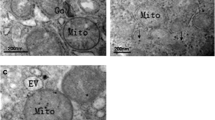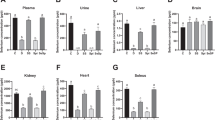Abstract
Effects of selenium deficiency, induced by thioacetamide, were investigated in rats. Thioacetamide (0.3 g/L) given in drinking water, as expected, caused a significant loss of selenium from the liver. It was accompanied by liver cirrhosis and a significant increase in the liver weight as well as liver to body weight ratio. A significant loss of selenium from spleen was also accompanied by an increase in its weight. Weights of lungs, testis and kidney, however, were not affected by thioacetamide and there was no change in their selenium content. Plasma levels of selenium were significantly reduced in the thioacetamide treated group. All these changes were confirmed to be due to selenium deficiency caused by thioacetamide, as supplementation with selenium reversed these changes. The mode of action of selenium is unknown but may involve anti-oxidant defense mechanisms.
Similar content being viewed by others
References
Schwartz K, Foltz CM: Selenium as an integral part of factor 3 against dietary necrotic liver degeneration. J Am Chem Soc 79: 3292–3293, 1957
Hofeman DG, Sunde RA, Hockstro WG: Effect of dietary selenium on erythrocyte and liver glutathione peroxidase in the rat. J Nutr 104: 580, 1974
Cantor AH, Scott ML, Noguchi T: Biological availability of selenium foodstuffs and selenium compounds for prevention of exudative dithesis in chicks. J Nutr 105: 96, 1975
Gwyneth L, Anderson PH: The nature of trace element problems: Delineating the field problem. In: NF Suttle et al. (eds). Trace Elements in Animal Production and Veterinary Practice. No. 7, BSAP, Edinburgh, UK, 1983 pp 11–16
Aaseth J, Thomassen Y, Alexander J. et al.: Liver diseases and trace elements (in Norwegian). Tidskr Nor Laegeforen 104: 225–228, 1984
McKeehan WL, Hamilaton WG, Ham RG: Selenium is an essential trace nutrient for growth of WI-38 diploid human fibroblasts. Proc Natl Acad Sci USA 73: 2023, 1976
Chen C, Yang GQ, Chen J, Wen Z, Ge K: Studies on the relations of selenium and Keshan disease. Biol Trace Elements Res 2: 91, 1980
Van Rij AM, Thomson CO, McKenzie JM, Robinson MF: Selenium deficiency in total parenteral nutrition. Am J Clin Nutr 32: 2076, 1979
Charez ER: Effect on dietary selenium depletion and replenetion plasma glutathione peroxidase activity and selenium concentration in blood and body tissue of growing pigs. Can J Anim Sci 59: 761, 1979
Thompson KG, Fraser AJ, Harrop BM, Kirk JA: Glutathione peroxidase activity in bovine serum and erythrocytes in relation to selenium concentrations of blood, serum and Liver. Res Vet Scl 28: 321, 1980
Dashti H, Jeppsson P, Hagerstrand I et al.: Thioacetamide and carbon tetrachloride-induced liver cirrhosis. Eur Surg Res 21: 83–91, 1989
Greeder GA, Milner JA: Factors influencing the inhibitory effect of selenium on mic innoculated with Ehrlich ascites tumor cells. Science 209: 825–825, 1980
Dashti HM, Abul H, Behbehani A et al.: Interleukin-8 and Trace Element Alterations in experimentally induced liver cirrhosis: The influence of zinc, selenium and allopurinol treatment. J Trace Elements Exp Med 9: 27–40, 1996
Diplock AT.: Metabolic aspects of selenium action and toxicity. CRC Crit Rev Toxicol 4: 271–329, 1976
Aaseth J, Thomassen Y, Alexander J et al.: Decreased serum selenium in alcoholic cirrhosis. New Engl J Med 303: 944–945, 1980
Aaseth J, Alexander J, Thomassen Y et al.: Serum selenium levels in liver diseases. Clin Biochem 15/69: 281–283, 1982
Chernick SS, Moe JG, Rodnan GP and Schwartz K: A metabolic lesion in dietary necrotic liver degeneration. J Biol Chem 217: 829–843, 1955
Thomson CD, Robinson MF: Selenium in human health and disease with emphasis on those aspects peculiar to New Zealand. Am J Clin Nutr 33: 303, 1980
Schwartz K: Development and status of experimental work on factor3-selenium. Fed Proc 20: 666–673, 1961
Leccia NT, Richard MJ, Beani JC et al.: Protective effect of selenium and zinc on UV-A damage in human skin. Photochem Photobiol 58: 548, 1993
Linder MC: Function and metabolism of trace elements. In: U Stawe (ed). Perinatal Physiology, 2nd ed. Plenum Press, New York, 1978 pp 425
Kiremidjian L, Stotzky G: Selenium and immune response, Envi Res 42: 277FF, 1987
Kaul N, Siviski-Illiskovic N, Hill M, Slejak J, Singal PK: Free radicals and the heart. J Pharmacol Toxicol Meth 30: 55–67, 1993
Author information
Authors and Affiliations
Rights and permissions
About this article
Cite this article
Al-Bader, A., Abul, H., Hussain, T. et al. Selenium and Liver Cirrhosis. Mol Cell Biochem 185, 1–5 (1998). https://doi.org/10.1023/A:1006850514295
Issue Date:
DOI: https://doi.org/10.1023/A:1006850514295




